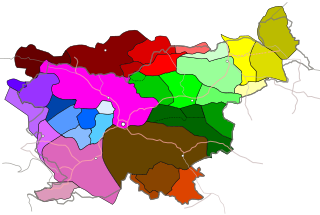
Back Prekmurees Afrikaans Esloveno prekmuro AN Idioma prekmuro AST Übermurisch BAR Прекмурско наречие Bulgarian Sloveneg Prekmurje Breton Prekmurski jezik BS Zámuřština Czech Prekmùrsczi jãzëk CSB Prekmurisch German
| Prekmurje Slovene | |
|---|---|
| Prekmurje dialect, Eastern Slovene, Wendish | |
| prekmürščina, prekmörščina, panonska slovenščina, prekmurščina, prekmursko narečje | |
| Native to | Slovenia, Hungary and emigrant groups in various countries[which?] |
| Ethnicity | Prekmurje Slovenes |
Native speakers | (undated figure of 110,000)[1] |
| Latin script | |
| Language codes | |
| ISO 639-3 | – |
| Glottolog | prek1239 |
 Map of Slovenian dialects. Prekmurje Slovene is marked in dark yellow at the top right. | |
Prekmurje Slovene, also known as the Prekmurje dialect, Eastern Slovene, or Wendish (Slovene: prekmurščina, prekmursko narečje, Hungarian: vend nyelv, muravidéki nyelv, Prekmurje Slovene: prekmürski jezik, prekmürščina, prekmörščina, prekmörski jezik, panonska slovenščina), is the language of Prekmurje in Eastern Slovenia, and a variety of the Slovene language.[2] As a part of the Pannonian dialect group,[3] it is spoken in the Prekmurje region of Slovenia and by the Hungarian Slovenes in the Vas County in western Hungary. It is used in private communication, liturgy and publications by authors from Prekmurje[4][5] as well as in television, radio and newspapers.[6][7][8][9] It is closely related to other Slovene dialects in the neighboring Slovene Styria as well as to Kajkavian with which it is mutually intelligible to a considerable degree, and forms a dialect continuum with other South Slavic languages.
Prekmurje Slovene is part of the Pannonian dialect group (Slovene: panonska narečna skupina), which is also known as the eastern Slovene dialect group (vzhodnoslovenska narečna skupina). Prekmurje Slovene shares many common features with the dialects of Haloze, Slovenske Gorice, and Prlekija, with which it is completely mutually intelligible. It is also closely related to the Kajkavian dialect of Croatian, although mutual comprehension is difficult. Prekmurje Slovene, especially its more traditional version spoken by the Hungarian Slovenes, is not readily understood by speakers from central and western Slovenia, whereas speakers from eastern Slovenia (Lower Styria) have much less difficulty understanding it. The early 20th-century philologist Ágoston Pável stated that Prekmurje Slovene is actually a major, independent dialect of Slovene, from which it differs mostly in the aspects of stress, intonation, the softening of consonants and—as a result of the lack of linguistic reform—in the striking dearth of modern vocabulary[10] and that it has preserved many older features from the Proto-Slavic language.
- ^ Cite error: The named reference
speakerswas invoked but never defined (see the help page). - ^ Greenberg 2020, p. 1:"There is reason to think of Prekmurje Slovene as a dialect of Slovene as well as a separate language. Indeed it has carried through many of the innovations that are characteristic of Slovene, shares most core vocabulary and grammatical structure, and from this perspective is part of a broader dialect group of the Pannonian group of Slovene dialects, together with the Slovenske gorice, Prlekija, and Haloze dialects, which in turn share a number of characteristics that differ from the rest of Slovene as well as neighboring Kajkavian dialects in Croatia (see Ramovš 1935, 171–193 for details). In favor of Prekmurje Slovene as a language it is written tradition, as it has been used for several centuries in a loosely standardized form, largely, but not exclusively, as a liturgical language. From a diachronic perspective, the Prekmurje Slovene offers a glimpse at a linguistic code that came into being through heterogeneous processes."
- ^ Logar, Tine. 1996. Dialektološke in jezikovnozgodovinske razprave. Ljubljana: SAZU, p. 240.
- ^ "Zapostavljeni spomin pokrajine - Prekmurska zgodovina kot primer spregleda lokalne zgodovine v učnem načrtu osnovnih in srednjih šol" [Neglected memory of a region - history of Prekmurje as an example of overlooked local history in curriculum of primary and secondary schools] (in Slovenian). Javna agencija za raziskovalno dejavnost Republike Slovenije [Slovenian Research Agency] (AARS). 2008.
- ^ Jesenšek, Marko (2008). "Trubarjeva in Küzmičeva različica slovenskega knjižnega jezika" [Trubar's and Küzmič's Variants of the Slovene Literary Language] (PDF). Slavistična revija (in Slovenian and English). Vol. 56, no. 4. COBISS 16738056.
- ^ RTV SLO: Nova radijska igra Bratonski pil v prekmurščini
- ^ Prekmurščina: Dnejvi so minejvali pa nika takšoga se nej zgoudilo (Dnevnik)
- ^ Prekmurci in prekmurščina (Prekmursko društvo General Maister)
- ^ NE SPREGLEJTE! Na TV IDEA nova oddaja TIJ SAMO GUČI z gostiteljem Mišem Kontrecem (Sobotainfo)
- ^ Greenberg 2020, p. 17.